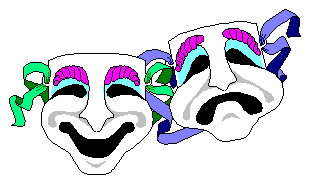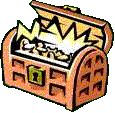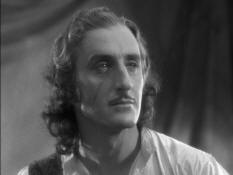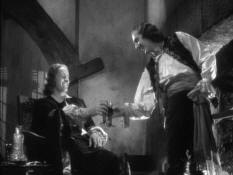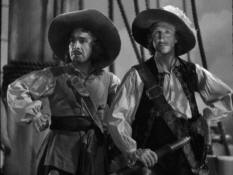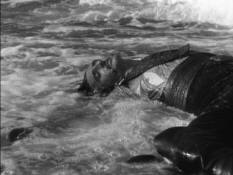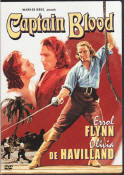Captain
Blood
|
|
Captain Blood Stirs Hearts at Oakland Rapiers flash, cannon roar, proud ships rake proud ships with murderous broadsides, slaves bend their backs to tremendous tasks—and the smile of a lovely lady taunts the handsome buccaneer who is scourge of the Spanish main. Long before the two hours of blistering action and breath-taking beauty of photography are at an end, the spectator is conscious that he has seen a new star of first magnitude swim into the cinema skies. He is Errol Flynn, an Irish star for an Irish role—that of Dr. Peter Blood, sentenced to slavery in Jamaica for treating a rebel against the English king, escaping to become the most daring and most gentlemanly corsair of his times. So handsome that he will stir every feminine heart, endowed with a grace of carriage and a charm of diction that are all too rare, Flynn's brilliant future is assured. Captain Blood is melodrama on the grand scale, unencumbered by probabilities; a tall tale of derring do, and Michael Curtiz, the director, has hewed to this line with a will. The action, always swift, sweeps into crisp tense drama in the sequence that begins when Blood signs partnership with the ruthless cutthroat Levasseur and ends when the Irishman's blade pierces the Frenchman on the sands of the isle of Vergen Magra. Basil Rathbone plays the blood-curdling Levasseur to the hilt. Olivia de Havilland brings both beauty and talent to the heroine role, and many other members of the large cast turn in stellar performances. Worthy of special note are Lionel Atwill, Vernon Steele, Guy Kibbee, George Hassel and Henry Stephenson. A very large element in the success of Captain Blood is the special musical score of E. W. Korngold. —by W. H. Grattan, The Oakland Post Enquirer, January 11, 1936 |
The highlight of the film is the duel between Captain Blood and Levasseur, which resulted in Levasseur's death. Rathbone and Flynn exhibit excellent swordplay. Rathbone's acting, and even his French accent, was superb. In an interview, Rathbone described the difficulty of filming that final swordfight on the beach:
According to the Warner Bros. press material, Errol Flynn broke three rapiers during the duel with Basil Rathbone. Also, Errol was wounded four times. The most serious wound was on the actor's head, slightly above the left temple. He also was cut by Basil Rathbone near the right eye, on the neck and on the right forearm.
The press book also contained the story that Flynn fell off a forty-foot cliff into the Pacific Ocean during the filming of the duel with Basil Rathbone. "In order to give the scene added drama, Director Michael Curtiz had Flynn drive Rathbone at swords point onto a small ledge on the side of a cliff overlooking the bay. The cliff was not quite perpendicular, however, sloping off gently so that the ledge was about ten or twelve feet shoreward and forty feet above the water line.
"With the cameras grinding, Flynn backed Rathbone onto the ledge according to instructions. For several minutes the rapiers of the duelists flashed. Then, suddenly, Flynn tripped on a small rock and toppled outward from the ledge. He strove to regain his footing, but when he finally realized there was no chance of saving himself, he put all his power into an outward leap. He soared out from the ledge, cut cleanly into the water, missing the base of the cliff by a mere matter of inches. He swam to the beach unaided. Flynn suffered nothing worse than a slightly lacerated knee which scraped a submerged rock." It seems unlikely that the studio would have risked the life of their star, but rather invented the story for publicity purposes.
Fencing master Fred Cavens choreographed the duel between Captain Blood and Levasseur, and doubled for Rathbone in some shots.
For more on the filming of the duel on the beach, see the analysis written by Benerson Little: https://benersonlittle.com/2022/03/29/the-duel-on-the-beach-part-iv-flynn-versus-rathbone-in-captain-blood/
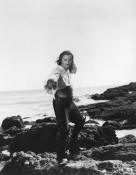 Fred Cavens (in costume as Levasseur) |
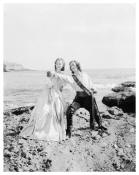 Olivia De Havilland and Basil Rathbone |
Robert Donat had originally been cast in the role of Captain Blood, but he backed out of the contract. Although 26-year-old Errol Flynn was under contract with Warner Brothers, he was virtually unknown, having had bit parts in only a few films. Olivia deHavilland was only 19 years old and also new to films, although this was not her first film. Warner Brothers was taking a huge risk casting these two newcomers in leading roles. But the risk paid off in a big way and both Errol Flynn and Olivia de Havilland became stars. Basil Rathbone was already an established and popular star by this time.
Production began August 5, 1935, with a twelve-week shooting schedule. Flynn signed to play Peter Blood in July; Rathbone signed to play Levasseur in September. The picture had more than forty principal actors and several thousand bit players and extras. An average of 400 extras were used daily.
An entire year elapsed from the starting of the work on the screen play to the time the picture came out of the cutting room ready for showing.
The production budget was $1,200,000; the final cost was approached $2,000,000.
Most of the scenes were shot on sound stages. The duel on the beach was filmed at Three Arch Bay, Laguna Beach, California. The final scenes, the love scenes between Errol Flynn and Olivia de Havilland, were filmed in Palm Canyon, near Palm Springs.
Warners' press book claimed that it took two months to film the sea battle. Director Michael Curtiz pointed out that in actual battle the combatants simply pitch in and fight until one side emerges victorious. In a film battle, this is not possible. Such a spectacle in pictures must be broken up into a hundred-odd parts—long shots, medium shots, close shots, various camera angles. Curtiz laid his plans accordingly, devising the routine for a spectacular battle.
Blood and his crew, of course, emerge victorious in the end. But how to achieve this end with the odds greatly against the buccaneer and yet make the victory ring true, was a hard problem.
After a discussion of several days with cameramen, technicians, writers and others, Curtiz decided upon a course requiring Blood's ship to sail into the harbor to discover the fort at the entrance exchanging fire with one French ship while the other, the Diligent, was blasting the town itself, some two miles distant.
Blood first engaged the ship firing on the fort. After a bitter short-range exchange of fire, a well-placed shot from the pirate ship, the Arabella, penetrated to the powder magazine of the French vessel, causing it to blow up and sink.
Meanwhile, the Diligent had swung about and was hurrying to the aid of its sister ship. The Arabella, having disposed of her first opponent, met the other French ship half way. Grappling irons were hurled aboard the French vessel and Blood's crew, led by the officers, boarded the Diligent.
When Curtiz finally began filming the battle scene he started with the long range navigating scenes. Then he switched to stunts—quick thrilling flashes of men tumbling from spars high above the decks (there were nets to catch them below) close, vicious struggles on crows' nests, men swinging through the air from one ship to the other at the ends of grappling ropes, groups of men being crushed under collapsing portions of decks or being swept to death by the ends of lashing ropes dragging from toppling masts. A group of Hollywood stunt men spent more than two weeks on this work alone.
Then Curtiz began the actual boarding scenes. It took a week to film this spectacle alone. All this, incidentally, for a sequence that lasts twenty minutes in the finished production.
|
Errol Flynn was perfect casting as Blood. Handsome, dashing, devil-may-care, he is utterly convincing as he leads his men to death or glory for freedom and for England. He is backed by a superb cast. ... The principal villain here is Lionel Atwill playing the brusque, humourless and unsympathetic Colonel Bishop. But he is completely upstaged by Basil Rathbone as the privateer Levasseur. In spite of a terrible French accent, he is the incarnation of the bold, bad buccaneer, the antithesis of Blood but a foe worthy of testing his mettle. The pencil-thin moustache, scar, raised eyebrow, flared nostrils, sneering voice and hands on hips are all quite perfect, and he delivers every line with relish, notably when threatening someone with something nasty, such as torture by whipcord. —Jeffrey Richards, Swordsmen of the Screen, 1977 |
According to studio publicity, tremendous settings were designed by master builders. These included great sailing vessels of the period, massive in size, which had to be specially built, complete in every detail; parts of a village in England; most of the old city of Port Royal, in the West Indies; the palace of King James II; a governor's mansion; and seventeenth-century costumes to suit everyone from King to slave.
In fact, building all of that full-scale would have been too expensive, and would have exceeded the film's budget. In an article for American Cinematographer, Fred Jackman (Director of Scientific Research at Warner Bros.) writes, "No full-scale ships were used; even the town of Port Royal and the island of Virgen Magra were for the most part in miniature. And no one was hurt in filming the thrill scenes. The dramatic action laid aboard ship was filed on one of the stages, where the main deck of the ship was recreated. When the ship was 'at sea,' ordinary sky backing and process backgrounds took care of the background. A relatively small set, built around the studio tank, took care of the few intimate shots of the principals at the town's waterfront. Port Royal was twice bombarded—once by Spanish privateers, and once by a French fleet; but the bombardment was carried out in miniature."
The miniature ships were not actually tiny; they wouldn't fit in your bathtub. The ships were more than 18 feet long and had 16-foot masts. The three miniature ships were built for $3,300. Building three full-size ships would have cost $180,000, so the miniatures provided significant cost savings for the studio.
The publicity material is not necessarily factual; the studio's goal was to make people want to see the film. Here is more from the studio press book:
Arming the Captain Blood players was another big job. The gun maker in the studio's arsenal made 50 cannons, 400 cap and ball pistols, 450 flintlock muskets, 350 powder horns, 50 powder barrels, 350 cutlasses, 200 cane knives and 300 daggers. Director Michael Curtiz insisted on realism. The cannons could not be dummies. They had actually to shoot They were mounted on fortifications and on ships for the battle scenes. Wherever possible, weapons actually made in 1685 were procured. But there were not enough of these guns, so studio technicians duplicated them. Several types of cannons are used: swivel guns, long guns and carronades.
Pictures of such guns were obtained and reproductions made, exact in every detail. The task of filling the order for cutlasses, cane knives, daggers, powder horns and barrels was not quite so difficult.
Seven special ships were built for Captain Blood. The construction was lighter; they had little durability. They wouldn't be able to weather the high seas. Yet, to the eye, not the slightest detail was missing. They were of regulation size, length, height and beam. Their decks were sturdy enough to support the hordes of weather-beaten pirates who used them for a battle ground.
Every player who took part in the battle scenes of the film understood that he took a chance of being hurt. It was necessary for the actors to risk their necks under falling spars, in hand to hand sword duels and on swinging ropes which carried them from one ship to another during a boarding battle. They braved the danger of flaming bits of wreckage dropped on them from above and they stood staunchly on the furiously burning deck of the good ship Arabella, waiting for orders to "abandon ship."
Fortunately the injuries were all of a minor nature and they were shared by featured players, stunt men and extras. In addition to the wounds Errol Flynn received during his duel with Basil Rathbone, several men were burned slightly and more than a dozen of them rubbed their hands raw on the swinging ropes. There were two sprained ankles and several minor cuts and bruises treated by the enlarged first aid staff which stood constantly on the sidelines of the battle scenes and there were sore muscles, black eyes and bloody noses galore. No one was killed or seriously or permanently injured.
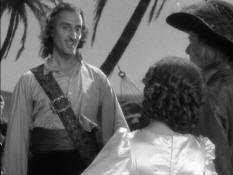 Levasseur has captured Lord Willoughby and Arabella Bishop |
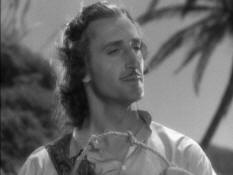 Levasseur threatens to "screw out" Lord Willoughby's eyes with this torture device. |
|
Although the official release date was December 28, 1935, Captain Blood appeared on screens in 189 key city theaters Christmas Day. The film broke the Christmas Day box office records at the Strand Theater on Broadway in New York City. Captain Blood was nominated for four Academy Awards: Best Picture, Best Director (Curtiz), Best Sound Editing, and Best Writing/Screenplay. It did not win any awards. The Academy of Motion Pictures voted for Mutiny on the Bounty as Best Picture of 1935, and Captain Blood as the third best film of 1935.
|
|
Watch the trailer for Captain Blood: |
.
See Page Two for more reviews and photos from the film. See Page Three for pictures of posters, lobby cards and promo photos.
.
|
Images on this page and pages 2 and 3 are from Captain Blood, copyright Warner Bros. Films.

